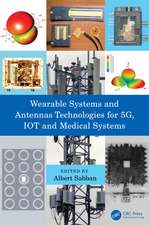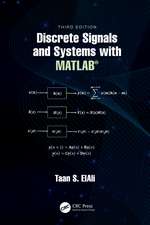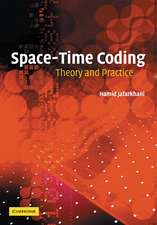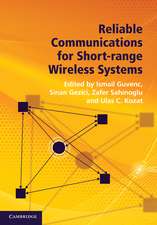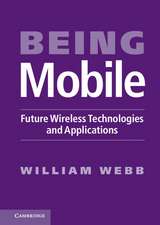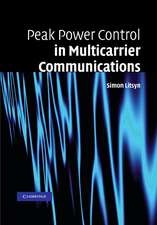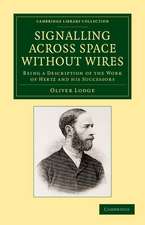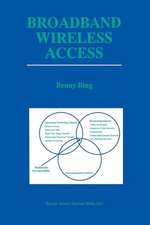Emerging Technologies in Wireless LANs: Theory, Design, and Deployment
Editat de Benny Bingen Limba Engleză Hardback – 4 noi 2007
Preț: 754.95 lei
Preț vechi: 877.85 lei
-14% Nou
Puncte Express: 1132
Preț estimativ în valută:
144.46€ • 150.83$ • 119.56£
144.46€ • 150.83$ • 119.56£
Carte tipărită la comandă
Livrare economică 04-18 aprilie
Preluare comenzi: 021 569.72.76
Specificații
ISBN-13: 9780521895842
ISBN-10: 0521895847
Pagini: 896
Ilustrații: 405 b/w illus.
Dimensiuni: 184 x 261 x 36 mm
Greutate: 1.5 kg
Ediția:1
Editura: Cambridge University Press
Colecția Cambridge University Press
Locul publicării:Cambridge, United Kingdom
ISBN-10: 0521895847
Pagini: 896
Ilustrații: 405 b/w illus.
Dimensiuni: 184 x 261 x 36 mm
Greutate: 1.5 kg
Ediția:1
Editura: Cambridge University Press
Colecția Cambridge University Press
Locul publicării:Cambridge, United Kingdom
Cuprins
Foreword; Preface; Part I. Introduction to 802.11: 1. Emerging IEEE 802.11 standards Luke Qian; 2. Guide to wireless LAN analysis Wildpackets Inc.; Part II. 802.11 Quality of Service: 3. WLAN QoS Mathilde Benveniste; 4. Performance understanding of IEEE 802.11 DCF and IEEE 802.11e EDCA Giuseppe Bianchi, Sunghyun Choi, Ilenia Tinnirello; 5. Cross-layer optimized video streaming over wireless multi-hop mesh networks Yiannis Andreopoulos, Nicholas Mastronarde and Mihaela van der Schaar; Part III. 802.11 Security: 6. Understanding and achieving next-generation wireless security Motorola; 7. Wireless local area network security Dorothy Stanley and Joshua Wright; Part IV. High throughput 802.11: 8. The 802.11n standard Richard VanNee; 9. MIMO spatial processing for 802.11n WLAN Bjorn Andre Bjerke, Irina Medvedev, John Ketchum, Rod Walton, Steven Howard, Mark Wallace and Sanjiv Nanda; Part V. 802.11 Mesh Networks: 10. Capacity of wireless mesh networks Stephen Rayment; 11. Autonomous mobile mesh networks and their design challenges Ambatipudi Sastry; 12. Service provisioning for wireless mesh networks John Macchione; 13. Metro-scale Wi-Fi networks Josef Kriegl and William Merrill; 14. Usage and performance comparison of mobile MetroMesh networks Devabhaktuni Srikrishna; 15. First, second and third generation mesh architectures Francis Dacosta; 16. Wireless mesh networks Jan Kruys and Luke Qian; Part VI. 802.11/Cellular Interworking: 17. WLAN interworking with 2G/3G systems Srinivasan Balasubramanian; 18. Towards service continuity in emerging heterogeneous mobile networks Sandro Grech, Henry Haverinen, Vijay Devarapalli and Jouni Mikkonen; 19. A survey of analytical modeling for cellular/WLAN interworking Enrique Stevens-Navarro, Chi Sun and Vincent Wong; Part VII. Coexistence: 20. Coexistence of unlicensed wireless networks Steve Shellhammer; 21. Coexistence of IEEE 802.11n and bluetooth Eldad Perahia; Part VIII. 802.11 Network and Radio Resource Management: 22. Measured WLANs: the first step to managed WLANs Richard Paine; 23. Cognitive WLAN - a better architecture Nestor Feses; Part IX. 802.11 range: 24. Wi-Fi range - impact on data rates, coverage, and capacity John DiGiovanni and Perry Correll; Part X. 802.11 Hardware Design: 25. An 802.11g WLAN system on a chip Atheros Communications, Tereas Meng and Bruce Wooley; 26. Antenna design for portable computers Frank Caimi, David Wittwer, Anatoliy Ioffe and Marin Stoytchev; Part XI. Wi-Fi Hotspots: 27. Service control and service management of Wi-Fi hotspots Jasbir Singh; 28. Hot spots - public access using 802.11 James Keeler; 29. Strategies for maximizing access to public commercial hot spots Boingo Wireless® Inc; 30. A discussion of 802.11 for sensor networks William Merrill, Dustin McIntire, Josef Kriegl and Aidan Doyle; 31. Wi-Fi based tracking systems Ekahau, Inc.; 32. Building the mobile computing environment through context-aware service management Appear; 33. Experiments using small unmanned aircraft to augment a mobile ad hoc network Timothy Brown et al. University of Colorado at Boulder; Part XIII. Ultra WideBand (UWB): 34. Ultra-wideband wireless technology Kai Siwiak and Yasaman Bahreini; 35. High-rate WPAN Dagnachew Birru and Vasanth Gaddam; Part XIV. Public Wireless Broadband: 36. Wireless cities British Telecom; 37. The path to 4G and the mobilization of the internet Philip Marshall; 38. All internet is local - five ways public ownership solves the U.S. broadband problem Becca Vargo Daggett; Epilogue; Index.
Recenzii
'An excellent resource for anyone who wants to understand the underpinnings and possibilities of the Wi-Fi offerings we see evolving in the marketplace today.' Robert J. Zack, Director, Next Generation Broadband, EarthLink Inc., USA
'This book explores all aspects of contemporary wireless LANs, from the basics through wireless security, meshes, QoS, high throughput, and interworking with external networks. The broad range of topics and perspective make this the ideal reference for experienced practitioners, as well as those new to the field.' Craig J. Mathias, Principal, Farpoint Group, USA
'This book is a wonderful resource for anyone who works with Wi-Fi wireless technologies. It provides an excellent overview for the newcomer and an extensive and up-to-date reference for the expert. This book is a crucial tool for everyone involved in this exciting, fast-paced field. Everyone will learn from it!' David F. Kotz, Director, Center for Mobile Computing, Darmouth College, USA.
'The ability of Wi-Fi technology to expand in so many directions while maintaining backwards compatibility has been one key to its success and the technology will certainly continue to evolve. This book has hopefully given you some insights into where we have been and where we may be headed.' Greg Ennis, Technical Director, WiFi Alliance
'This book explores all aspects of contemporary wireless LANs, from the basics through wireless security, meshes, QoS, high throughput, and interworking with external networks. The broad range of topics and perspective make this the ideal reference for experienced practitioners, as well as those new to the field.' Craig J. Mathias, Principal, Farpoint Group, USA
'This book is a wonderful resource for anyone who works with Wi-Fi wireless technologies. It provides an excellent overview for the newcomer and an extensive and up-to-date reference for the expert. This book is a crucial tool for everyone involved in this exciting, fast-paced field. Everyone will learn from it!' David F. Kotz, Director, Center for Mobile Computing, Darmouth College, USA.
'The ability of Wi-Fi technology to expand in so many directions while maintaining backwards compatibility has been one key to its success and the technology will certainly continue to evolve. This book has hopefully given you some insights into where we have been and where we may be headed.' Greg Ennis, Technical Director, WiFi Alliance
Descriere
Wireless LANs have become mainstream over the last few years. What started out as cable replacement for static desktops in indoor networks has been extended to fully mobile broadband applications involving moving vehicles, high-speed trains, and even airplanes. This book is designed to appeal to a broad audience with different levels of technical background and can be used in a variety of ways: as a first course on wireless LANs, as a graduate-level textbook, or simply as a professional reference guide. It describes the key practical considerations when deploying wireless LANs and equips the reader with a solid understanding of the emerging technologies. The book comprises 38 high-quality contributions from industry and academia and covers a broad range of important topics related to 802.11 networks, including quality of service, security, high throughput systems, mesh networking, 802.11/cellular interworking, coexistence, cognitive radio resource management, range and capacity evaluation, hardware and antenna design, hotspots, new applications, ultra-wideband, and public wireless broadband. Benny Bing is a research faculty member with the School of ECE, Georgia Institute of Technology, USA. He is an IEEE Communications Society Distinguished Lecturer, IEEE Senior Member, and Editor of the IEEE Wireless Communications Magazine.

